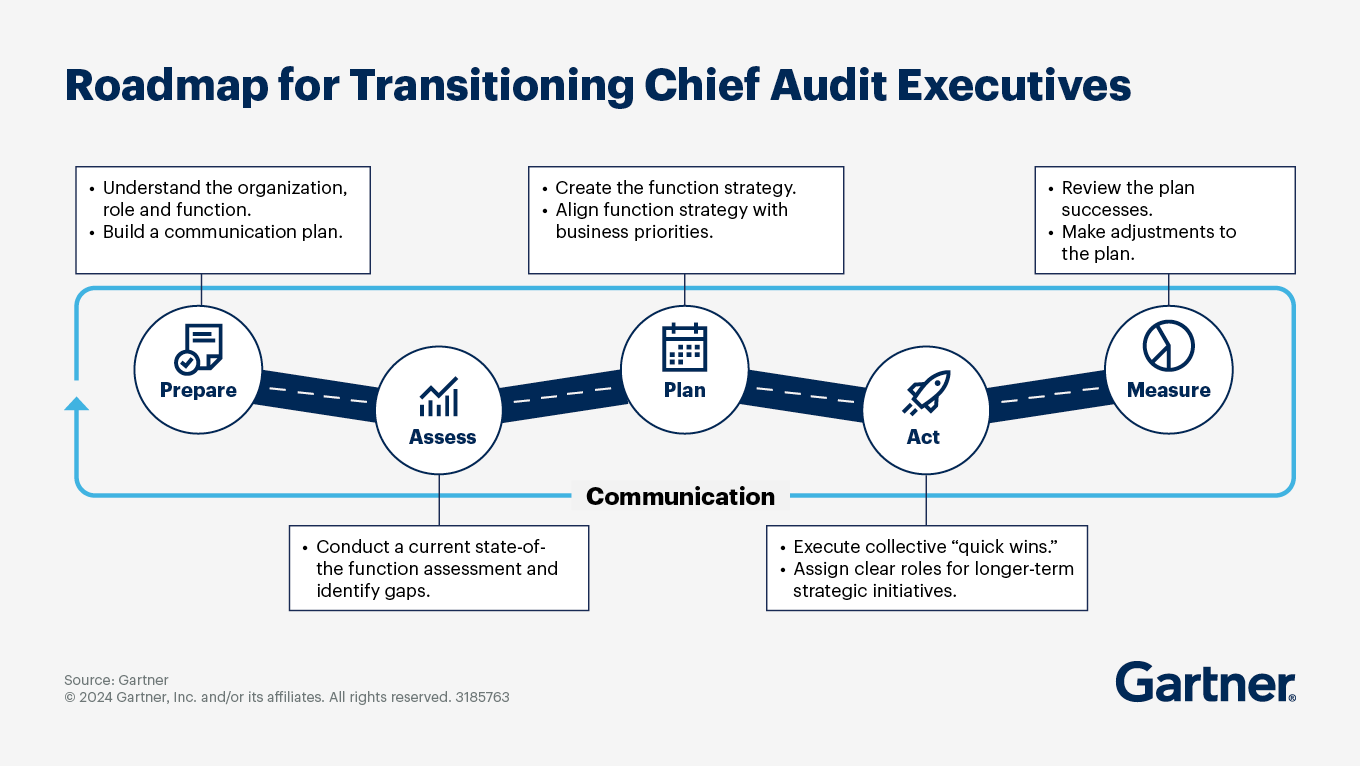Learn key strategies to fast-track your success as a new CAE.
- Gartner client? Log in for personalized search results.
New Chief Audit Executive Toolkit

Only 28% of audit departments are confident their audit engagement cycles can keep pace with the speed of the business.
As Chief Audit Executives (CAEs) face increasing expectations from boards and senior executives, new CAEs need to create a formal transition plan to build a strong foundation for their tenure.
Download the Gartner Toolkit for New Chief Audit Executives to get access to:
- First 100 Days Guide for Chief Audit Executives
- CAE Personal Effectiveness Diagnostic Tool
- 2024 Leadership Vision for Chief Audit Executives
- Audit Score Maturity Assessment and Prioritisation Tool
- Audit Strategic Planning Guide and Template
- 2024 Audit Plan Hot Spots
About the Chief Audit Executive Role
Heightened business attention on areas such as generative AI, ESG, culture and fast-evolving cyberthreats requires audit to further expand its coverage in less familiar areas. This shift leaves many Chief Audit Executives (CAEs) worried about their teams’ ability to provide necessary assurance. To keep pace, CAEs must continuously develop new and effective audit approaches, use more data, and deliver high-quality audit and advisory services to support the business.
Only 38% of audit departments are confident their current audit methodologies are sufficient to deal with newer audit areas, and only 28% are confident their audit engagement cycles can keep pace with the speed of the business. Further, challenges with slow-evolving IT auditing practices that don’t keep pace with new technologies and IT risks leave audit departments with limited confidence they can provide adequate assurance over some of the most important risks. Forty-six percent of CAEs report their teams struggle to provide assurance over critical transformation projects and 52% over cybersecurity. As the risk landscape continues to evolve and grow, audit methodologies and processes need to become faster and more dynamic to keep up.
Chief Audit Executive FAQs
Where should Chief Audit Executives focus their efforts for a fast start?
To quickly transition into a new CAE role and make a positive impact, you must:
- Connect with key stakeholders throughout the enterprise and assess internal audit’s maturity by asking stakeholders targeted questions and using maturity assessments.
- Identify quick wins or immediate needs of the function and align their plans to the organization’s goals by seeking feedback from key stakeholders and the internal audit team on their concerns and expectations of the role.
- Create trust they can leverage over the course of their tenure by building relationships with cross-functional peers and direct reports. Keep them updated on the role’s activities.
What makes an effective Chief Audit Executive?
CAEs seeking to improve their effectiveness should:
Stay risk oriented by tracking external trends, ensuring stakeholders are aware of emerging risks and addressing risk root causes.
Manage stakeholders effectively by connecting with them outside standard project update meetings and proactively monitoring their top concerns.
Improve team leadership by routinely helping internal audit members to understand the relationship between their work and the department’s vision. Further, mentor team members to achieve their personal and professional goals.
What are the top trends impacting Chief Audit Executives?
The following are top trends CAEs must address this year:
Increased audit technology investments — In efforts to increase audit efficiency, coverage and quality, nearly half (49%) of CAEs plan to increase spend on internal audit technology in the next fiscal year.
More audit involvement in risky critical transformation projects — Organizations are experiencing a multitude of transformations, including abrupt business model change, evolving ways of working and expanding digitalization initiatives. As a result, the portion of audit plans devoted to critical transformation projects grew from 10% in 2020 to 17% in 2023.
Broad increase in CAEs’ expectations — In addition to the new IIA standards, which greater emphasize rigorous audit strategic plans, 64% of CFOs expect CAEs to demonstrate greater risk knowledge, and 51% of audit committee members expect audit to cover new or evolving and more complex risk areas, such as cybersecurity.